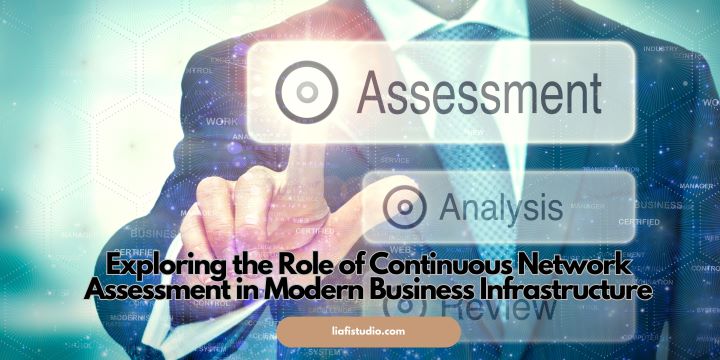Table of Contents:
- Introduction to Network Assessment
- Critical Elements of Network Assessment
- The Evolution of Network Assessment Practices
- Challenges in Achieving Continuous Network Assessment
- Benefits of Continuous Network Assessment
- Tools and Technologies Enabling Continuous Assessment
- How Continuous Assessment Influences Cybersecurity
- Adopting a Continuous Network Assessment Strategy
- Continuous Network Assessment and Cloud Infrastructure
- Future Trends and Innovations in Network Assessment
Key Takeaways
- Understanding the dynamics of continuous network assessment is indispensable for network health and cybersecurity.
- Leveraging technology advancements, such as AI, is altering the network management landscape.
- Continuous innovation in assessment tools and strategies is crucial for future-proofing business networks.
Introduction to Network Assessment
Network assessment is akin to conducting a full diagnostic check on a vehicle to ensure everything runs smoothly and safely. In the realm of information technology, such assessments provide an in-depth look into a network’s operational integrity and security. The goal is to identify potential issues and lay the groundwork for maintaining optimal performance as user demands and technologies evolve. A network assessment can uncover inefficiencies, redundancies, and weaknesses that might otherwise go unnoticed until they become significant problems. The significance of a comprehensive, strategic network security assessment must be considered in today’s digitized business environment, where data breaches and downtime can have monumental repercussions on an enterprise’s viability.
Critical Elements of Network Assessment
Mapping Network Topology
The foundation of a robust network assessment process begins with precise network topology mapping. This critical first step serves a dual purpose: it clearly visualizes the network’s architecture. It highlights how each component, whether hardware or software, interlinks and communicates. Much like a city’s blueprint informs urban planners, a well-documented network topology guides IT professionals in optimizing and securing the digital ecosystem. From routers and switches to data centers and cloud services, every aspect of the network is mapped to understand the ripple effect that any single point of failure may cause across the enterprise.
Identifying Network Performance Benchmarks
Identifying and setting network performance benchmarks is another pillar of network assessment. These benchmarks, which include network speed, latency, packet loss, and uptime metrics, act as a barometer for the network’s efficiency and reliability. Establishing these standards is not just about sticking to a baseline; it’s about striving for continuous improvement as network demands fluctuate. IT teams employ these benchmarks to pinpoint performance deviations, thus preempting potential disruptions that could escalate into more pronounced downtime or data loss instances.
Security Vulnerabilities and Compliance Checks
Network security is under the microscope when assessing cyber threats that are growing in sophistication and frequency. The process rigorously evaluates the network for vulnerabilities that malicious actors could exploit. Each potential risk is identified and prioritized for remediation, from out-of-date software to misconfigured firewalls. Additionally, compliance checks ensure the network adheres to industry regulations and standards. This is especially critical for finance, healthcare, and government sectors, where data protection is heavily legislated.
The Evolution of Network Assessment Practices
Network assessment practices have undergone a significant transformation in recent years. Movements from manual, episode-driven evaluations to ongoing, automated monitoring highlight the dynamic changes in this field. Conventional methods were suitable for static, uncomplicated network environments. However, with the exponential growth in connected devices and the subsequent complexity this brings, real-time, continuous assessment has become the norm. Machine learning algorithms and AI-enhanced tools now actively monitor data streams, adapt to new security threats on the fly, and suggest optimizations without requiring constant human oversight. A forward-looking perspective shared by many technology leaders, as reflected in Forbes Technology Council’s insights, champions AI as a future linchpin in network operations, signaling a trend towards more intelligent, more resilient networks.
Challenges in Achieving Continuous Network Assessment
Implementing a continuous network assessment framework comes with its set of trials. IT infrastructures are often sprawling and intricate, with legacy systems and cutting-edge solutions to consider. A sizable investment in technology and training can be requisite to conduct assessments effectively. Another challenge arises in striking the proper equilibrium between proactive network strategies and reactive problem-solving, all while ensuring the optimal allocation of resources and time to monitor network health continuously.
Benefits of Continuous Network Assessment
The advantages procured from continuous network assessment are numerous and profound. Primarily, it fosters enhanced network reliability and uptime—a crucial factor for any organization’s operational continuity. IT departments become more proactive and less reactive, directly benefiting from increased productivity and enabled by efficient troubleshooting methods. Managers and decision-makers are empowered with real-time analytics, comprehensive reports, and actionable data, significantly improving strategic planning and forging informed IT policies.
Tools and Technologies Enabling Continuous Assessment
Network Monitoring Software: Features and Functions
The key to the successful implementation of continuous network assessment practices is deploying advanced network monitoring software. These tools encompass various features designed for in-depth network surveillance and analysis. They can proactively detect performance anomalies, provide real-time alerts, automated diagnostics, and even predictive insights that preemptively identify potential issues before they impact the network’s operation.
The Role of Automation in Continuous Assessment
The power of automation in the realm of network assessment is transformative. It cuts down on manual checks, streamlines processes, and refocuses the attention of IT staff towards more strategic tasks. Whole routines previously the domain of network administrators can now be set up to run autonomously, saving precious time and significantly reducing the possibility of human error.
How Continuous Assessment Influences Cybersecurity
The intersection of continuous network assessment with cybersecurity is both clear and critical. Continued monitoring of the network landscape makes for a vigilant watch against unusual activity that may indicate a cyber threat. Establishing and maintaining a robust security posture requires ongoing vigilance and a solid foundation in network fundamentals to adapt security measures to evolving threats, mitigate risks proactively, and maintain compliance with the strictest of industry-wide regulations.
Adopting a Continuous Network Assessment Strategy
When implementing a proactive, continuous network assessment strategy, following best practices and ensuring that IT teams are well-equipped is critical. Through comprehensive training and the development of broad skill sets among staff, organizations can better manage and monitor their networks. Additionally, a focus on setting and tracking precise Key Performance Indicators (KPIs) will deliver tangible insights into the health and performance of network infrastructure.
Continuous Network Assessment and Cloud Infrastructure
Network assessment has entered a new domain with the ever-increasing adoption of cloud technologies. Managing the interplay between on-premises equipment and cloud-based services introduces another layer of complexity that necessitates a cohesive assessment approach. The move towards multi-cloud and hybrid networks further underscores the need for assessment tools that can nimbly navigate and optimize these blended environments.








